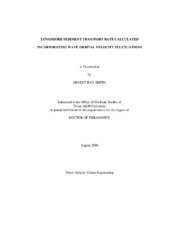| dc.description.abstract | Laboratory experiments were performed to study and improve longshore sediment
transport rate predictions. Measured total longshore transport in the laboratory was
approximately three times greater for plunging breakers than spilling breakers. Three
distinct zones of longshore transport were observed across the surf zone: the incipient
breaker zone, inner surf zone, and swash zone. Transport at incipient breaking was
influenced by breaker type; inner surf zone transport was dominated by wave height,
independent of wave period; and swash zone transport was dependent on wave period.
Selected predictive formulas to compute total load and distributed load transport
were compared to laboratory and field data. Equations by Kamphuis (1991) and Madsen
et al. (2003) gave consistent total sediment transport estimates for both laboratory and
field data. Additionally, the CERC formula predicted measurements well if calibrated
and applied to similar breaker types. Each of the distributed load models had
shortcomings. The energetics model of Bodge and Dean (1987) was sensitive to
fluctuations in energy dissipation and often predicted transport peaks that were not
present in the data. The Watanabe (1992) equation, based on time-averaged bottom stress, predicted no transport at most laboratory locations. The Van Rijn (1993) model
was comprehensive and required hydrodynamic, bedform, and sediment data. The
model estimated the laboratory cross-shore distribution well, but greatly overestimated
field transport.
Seven models were developed in this study based on the principle that transported
sediment is mobilized by the total shear stress acting on the bottom and transported by
the current at that location. Shear stress, including the turbulent component, was
calculated from the wave orbital velocity. Models 1 through 3 gave good estimates of
the transport distribution, but underpredicted the transport peak near the plunging wave
breakpoint. A suspension term was included in Models 4 through 7, which improved
estimates near breaking for plunging breakers. Models 4, 5 and 7 also compared well to
the field measurements.
It was concluded that breaker type is an important variable in determining the
amount of transport that occurs at a location. Lastly, inclusion of the turbulent
component of the orbital velocity is vital in predictive sediment transport equations. | en |


